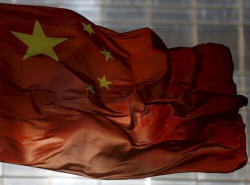|
Borrowing costs for
Chinese firms is key obstacle to private investment:
NDRC
 Send a link to a friend
Send a link to a friend
 [July 25, 2016]
BEIJING (Reuters) - Borrowing costs
and access to funding are the key obstacles to private investment in
China, a senior official at the top economic planning agency said on
Monday, after private investment growth shrank to a record low. [July 25, 2016]
BEIJING (Reuters) - Borrowing costs
and access to funding are the key obstacles to private investment in
China, a senior official at the top economic planning agency said on
Monday, after private investment growth shrank to a record low.
A government spending spree and housing boom helped China's economy
grow 6.7 percent in the second quarter, but a sharp slump in private
investment is pointing to a loss of momentum and worrying
policymakers.
Growth in investment by private firms, which accounts for over 60
percent of total investment in China, fell to a new record low in
the first half of the year as businesses retrench in the face of a
sluggish economic outlook and weak exports.
Executives at China's private sector are now adopting a "wait and
see" approach on investment, Zhang Yong, the deputy chair of the
National Development Reform Commission (NDRC) told reporters in
Beijing.
Xu Kunlin, the head of the NDRC's investment office, said at the
same news briefing that difficulty in obtaining financing is the
most common and prominent problem that companies face now.
"Loan tenors are relatively long, the cost is relatively high and if
you want to roll over a loan you run into lots of problems," said Xu.

"Some companies aren't able to smoothly roll over loans so they have
no choice but to turn to other fundraising avenues where the costs
are even higher and that's when many companies run into lots of
problems. So this really is a serious issue."
Zhang added that China should increase government investment, while
adding that government investment should not compete with that of
the private sector. Chinese banks typically prefer the security of
state-owned borrowers.
Private firms had to pay 6 percentage points more in interest for
bank loans in the second quarter versus the public sector, analysts
at investment bank CICC estimate.
An increasing reliance on state firms to support economic growth is
also making investment in China less efficient.
From 2003 to 2008, when annual growth averaged more than 11 percent,
it took just one yuan of extra credit to generate one yuan of GDP
growth, according to Morgan Stanley calculations.
[to top of second column] |

China's national flag flutters at a business district in Beijing,
October 29, 2015. REUTERS/Kim Kyung-Hoon

This year it has taken six yuan to produce one yuan of growth, Morgan Stanley
said, twice even the level in the United States during the debt-fueled housing
bubble that triggered the global crisis.
Sheng Songcheng, director of the Survey and Statistics Department at the
People's Bank of China (PBOC), said recently that China has already fallen into
a "liquidity trap" where increased money supply is being absorbed by firms that
are not in turn investing the cash.
While monetary policy is effective, it is limited and requires coordination with
a proactive fiscal policy. And Sheng said China has room to increase its fiscal
deficit ratio to between 4 and 5 percent to more effectively boost the economy.
China's cabinet last week unveiled detailed measures, including widening
financing channels for firms and establishing new equity funds, to support
investment and economic growth.
(Reporting by Sue-lin Wong and Beijing Monitoring Desk; Editing by Kim Coghill)
[© 2016 Thomson Reuters. All rights
reserved.] Copyright 2016 Reuters. All rights reserved. This material may not be published,
broadcast, rewritten or redistributed.
 |